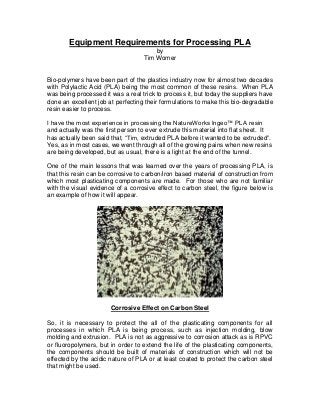
Equipment Requirements for Processing PLA by Tim Womer
- 1. Equipment Requirements for Processing PLA by Tim Womer Bio-polymers have been part of the plastics industry now for almost two decades with Polylactic Acid (PLA) being the most common of these resins. When PLA was being processed it was a real trick to process it, but today the suppliers have done an excellent job at perfecting their formulations to make this bio-degradable resin easier to process. I have the most experience in processing the NatureWorks Ingeo™ PLA resin and actually was the first person to ever extrude this material into flat sheet. It has actually been said that, “Tim, extruded PLA before it wanted to be extruded”. Yes, as in most cases, we went through all of the growing pains when new resins are being developed, but as usual, there is a light at the end of the tunnel. One of the main lessons that was learned over the years of processing PLA, is that this resin can be corrosive to carbon/iron based material of construction from which most plasticating components are made. For those who are not familiar with the visual evidence of a corrosive effect to carbon steel, the figure below is an example of how it will appear. Corrosive Effect on Carbon Steel So, it is necessary to protect the all of the plasticating components for all processes in which PLA is being process, such as injection molding, blow molding and extrusion. PLA is not as aggressive to corrosion attack as is RPVC or fluoropolymers, but in order to extend the life of the plasticating components, the components should be built of materials of construction which will not be effected by the acidic nature of PLA or at least coated to protect the carbon steel that might be used.
- 2. The Screw For screws of any plasticating process, the best material of construction is 17-4 ph Stainless Steel. This grade of stainless steel is readily available and can easily be machined and also have a nickel based flight hard facing welded on to it and a superior product versus a 4140 HT based screw which has been chrome plated. The 17-4 ph stainless has approximately 16% chromium in its chemical matrix whereas 4140 steel only as .8 to 1.1% chromium, which is the reason for the excellent corrosion protection. The cost of the 17-4 ph Stainless screw will be at a premium, but the big advantage is that on chrome plated screws once the chrome has worn away, the PLA will corrode the 4140 base material. Also, the screw can be cleaned over and over without the worry of polishing through the .001” thick chrome which normally applied to the screw surface. The other big advantage for using 17-4 ph Stainless Steel for the base material of the PLA screw, especially for small screws, 2” (50mm) and smaller, you are less likely to over torque the screw and cause it to break. Again, in comparing 17-4 ph stainless to 4140, 4140 HT Steel has about 95,000 psi yield strength whereas 17-4 has a yield strength of approximately 175,000 psi, it is almost twice as strong. Again, a great reason to use 17-4 ph stainless for any small screw application. The Barrel With the barrel, it is not quite as complicated. Basically there are two main different barrel liners that are available, either iron-based or nickel-based matrixes. The barrels which most original equipment manufacturers supply with new machines for injection molding, blow molding and extrusion are the ironbased lined barrels. These liners are industrially known as the Xaloy 102, Wexco 666 or Reiloy 112. For corrosion protection of the barrel is it best to use the nickel-based barrel bimetallic liners which have the industrial nomenclature, Xaloy 800, Wexco 777 and Reiloy 121. Down-Stream Components Also, while processing PLA, not only does the screw and barrel need to be protected but the components in front of the screw and barrel also need to be made of materials which have corrosion resistance. For injection molding of PLA, the endcap, nozzle adapter and tip should be made of 17-4 ph stainless steel or chrome plated internals. The 17-4 ph stainless is the preferred way to go for the best overall corrosion protection.
- 3. For extrusion and blow molding applications, all of the adapters, screen changers, melt pumps, and flow tubes should also be made of 17-4 ph stainless steel or other corrosion resistant type of stainless or all of the polymer flow paths should be chrome plated a minimum of .002” thick just is done for processing RPVC. As I said earlier, processing of PLA has come a long way from 20 years ago, now any one who plans on processing PLA as a primary polymer on their equipment needs to make sure that all of the materials of construction for the plasticating components are corrosion resistant. Good luck and good processing.
